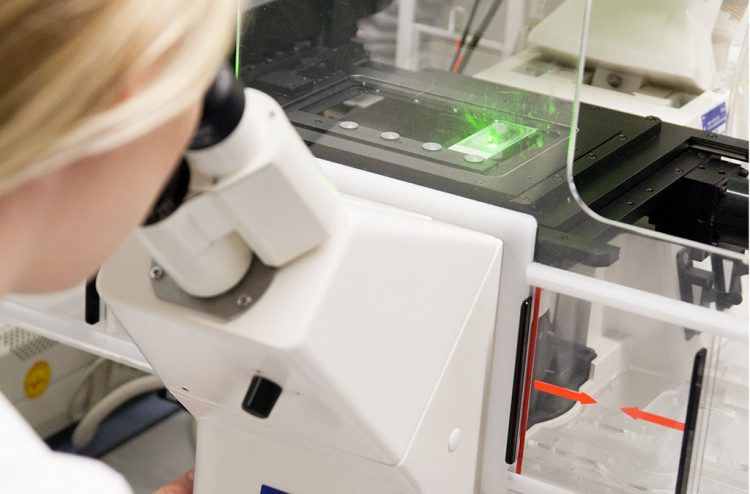Determining ion beam effects to greater precision: Researchers conduct high-res analyses on lesions in tissue

Scientists from Darmstadt were the first to analyse 3D lesion distribution in biological tissue on the submicrometre level. Picture: Thanh Nguyen
The biological effects of radiation consist in the damage caused to genetic information (DNA) contained in every cell nucleus. However, cells feature powerful repair mechanisms that can undo a lot of the damage caused by radiation.
That ion beams can induce greater effects than conventional photon (e.g. X ray) radiation can be explained by the extremely high energy they emit over a very small space around the ions’ path. In other words, ion beams can induce highly complex local damage that is far more resistant to repair efforts than the damage caused by photon radiation.
The conceptions favoured to date of ion beam induced 3D lesion patterns are based above all on theoretical considerations deduced from measurements of physical properties. There are no measurement data available for biological systems.
In a joint research project, scientists at the TU Darmstadt and GSI Hemholtzzentrum für Schwerionenforschung were the first to analyse 3D lesion distribution in biological tissue on the submicrometre level and to compare their findings with theoretical predictions. The radiation experiments at GSI used high energy ion beams with the same characteristics as the cosmic radiation in space.
Identification with marker
The analyses were conducted on a tissue with a particularly high density of cell nuclei, facilitating a virtually continuous detection of DNA damage. The identification of damage involved the use of a marker for the most serious form of biological damage, the DNA double strand break, causing the irreversible loss of key genetic information. This experimental approach can visualise the traces of ion induced DNA damage over many cells. The measurements show clearly the concentration of damage at the centre of the ion path and a rapidly declining lesion frequency away from this.
Effects predicted to greater precision
On the one hand, these biological findings confirm the assumptions of 3D lesion distribution based on measured physical properties. On the other, they can be used for a critical analysis and quasi calibration of the various prediction models. These data provide an essential constituent of a model for the prediction of radiation efficacy that was developed by GSI physicists and applied for treatment planning at the ion beam therapy centres in Heidelberg, Marburg, Pavia, and Shanghai for their tumour treatment schedules.
Further information
All details can be found in “Direct Measurement of the 3-Dimensional DNA Lesion Distribution Induced by Energetic Charged Particles in a Mouse Model Tissue” by Johanna Mirsch, Francesco Tommasino, Antonia Frohns, Sandro Conrad, Marco Durante, Michael Scholz, Thomas Friedrich, and Markus Löbrich published in the Proceedings of the National Academy of Sciences of the United States of America (PNAS):
http://www.pnas.org/content/early/2015/09/17/1508702112.abstract
MI-Nr. 62e/2015, ml/feu
http://www.pnas.org/content/early/2015/09/17/1508702112.abstract publication online
Media Contact
More Information:
http://www.tu-darmstadt.de/All latest news from the category: Physics and Astronomy
This area deals with the fundamental laws and building blocks of nature and how they interact, the properties and the behavior of matter, and research into space and time and their structures.
innovations-report provides in-depth reports and articles on subjects such as astrophysics, laser technologies, nuclear, quantum, particle and solid-state physics, nanotechnologies, planetary research and findings (Mars, Venus) and developments related to the Hubble Telescope.
Newest articles

Webb captures top of iconic horsehead nebula in unprecedented detail
NASA’s James Webb Space Telescope has captured the sharpest infrared images to date of a zoomed-in portion of one of the most distinctive objects in our skies, the Horsehead Nebula….

Cost-effective, high-capacity, and cyclable lithium-ion battery cathodes
Charge-recharge cycling of lithium-superrich iron oxide, a cost-effective and high-capacity cathode for new-generation lithium-ion batteries, can be greatly improved by doping with readily available mineral elements. The energy capacity and…

Novel genetic plant regeneration approach
…without the application of phytohormones. Researchers develop a novel plant regeneration approach by modulating the expression of genes that control plant cell differentiation. For ages now, plants have been the…





















